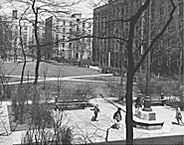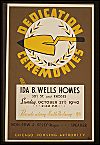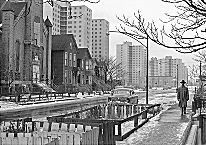| Entries |
| S |
|
Subsidized Housing
|

|
If the definition of subsidized housing includes homes built by philanthropists willing to make only a modest profit, or no profit, there were four early subsidized housing developments in Chicago. The first, constructed on the West Side in 1895, was Francisco Terrace, designed by then 28-year-old Frank Lloyd Wright. The developer, Edward Waller, planned to earn only 3 percent, or one-half of the then going rate, on his investment. The apartments were rented for $12 a month, mostly to newlyweds of modest means. This 44-unit “model tenement” stood at 255 North Francisco until being demolished in 1974.
The next large-scale endeavor was the Garden Homes, constructed in 1919 by Benjamin J. Rosenthal, a real-estate developer and civic leader. In Reconstructing America (1919) he asked, “Can a workman be efficient if he is crowded in a badly lighted, unclean house in a congested neighborhood? Can he be happy if he is obliged to occupy living rooms unfit for human habitation?” The answer was no for Rosenthal, so he purchased six blocks of land at 87th and State Streets and built 133 detached houses and 21 double ones. Their architecture is reminiscent of English cottages, and the project is based on England's “garden city” developments. Rosenthal originally sold the houses for $5,700.
The city's largest philanthropic housing developments are the Michigan Boulevard Garden Apartments, at 47th and Michigan, and the Marshall Field Garden Apartments in Old Town, both built in 1929 and both modeled after the Dunbar Apartments built by John D. Rockefeller, Jr., in 1926 in New York City's Harlem.
The Michigan Boulevard Garden Apartments were built by philanthropist Julius Rosenwald, who controlled Sears, Roebuck. Covering a square block, the buildings enclose an enormous central landscaped courtyard. Rosenwald built the development of 421 units to provide sound housing for African Americans and to relieve the tremendous overcrowding due to the extensive racial segregation of Chicago. The development also included 14 stores along the 47th Street side of the property, four of which were occupied by black-owned businesses, and a nursery school. Rosenwald invested $2.7 million in the project, receiving only a 2.4 percent return during the first seven years.

|
Construction of subsidized housing resumed after World War II. The Depression and the war had created the most severe housing shortage in Chicago's history, especially for poor people. In 1948 the CHA created the Chicago Dwellings Association as a private corporation to construct housing for moderate-income families. In 1953 it built the 318-unit Midway Gardens, at 60th and Cottage Grove, and several smaller developments. Other nonprofit developers included the Community Renewal Foundation and the Kate Maremont Foundation, which by 1963 had purchased the Michigan Boulevard Garden Apartments. The efforts of these groups met with mixed results at best, and new initiatives were few and far between.

|
The grand experiment of the last third of the twentieth century involved rent vouchers, issued initially under Section 23 of the U.S. Housing Act of 1965 and later under the Section 8 program. They fall into two categories; project-based subsidies attach to all or a designated group of apartments in a development; “finders keepers” certificates can be used by a tenant for any apartment that passes a Section 8 inspection and whose landlord agrees to participate in the program. Section 8 tenants pay 30 percent of their income for rent, after certain adjustments for factors like family size; the majority of the rent is paid by the federal government. However, there are enough vouchers available to help only a fraction of the families with incomes low enough to qualify. Also, many landlords decline to participate for one reason or another, and many apartments do not pass Section 8 inspections.
At the turn of the century, CHA was demolishing much of the housing it had built, especially high-rises, and constructing fewer new units, many in mixed-income developments. The majority of the displaced tenants have received Section 8 certificates, leaving them at the mercy of the market and discriminatory rental practices. The city's efforts to provide housing assistance have been channeled into various programs to aid organizations or developers in constructing new or rehabilitated single-room occupancy housing for potentially homeless people and programs to assist middle-income first-time home buyers. The latter programs fit neatly into the most widespread forms of public subsidy for private housing across the United States—inexpensive mortgages insured through Federal Housing Authority and Veterans Administration programs and the mortgage tax deduction. Since the 1950s, these public subsidies have helped expand home ownership and increase housing values across the metropolitan area.
The Encyclopedia of Chicago © 2004 The Newberry Library. All Rights Reserved. Portions are copyrighted by other institutions and individuals. Additional information on copyright and permissions.